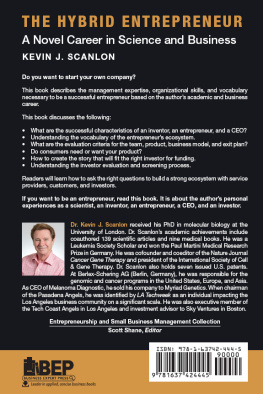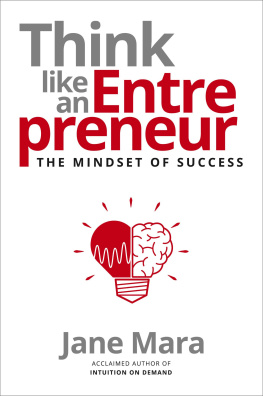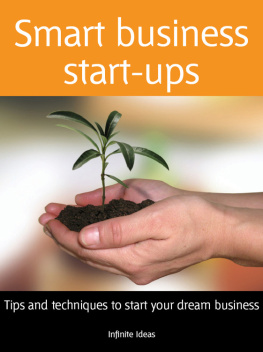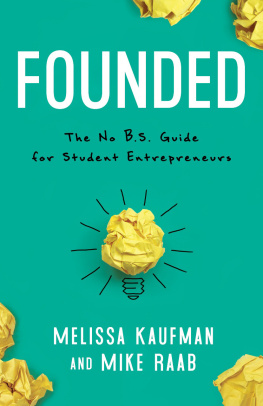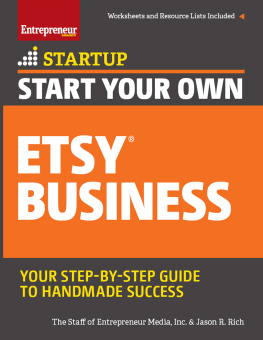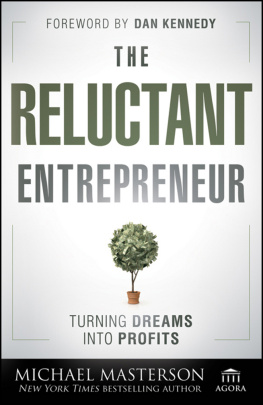Thank you for downloading this
AMACOM eBook.
Sign up for our newsletter, AMACOM BookAlert, and receive special offers, access to free samples, and info on the latest new releases from AMACOM, the book publishing division of American Management Association.
To sign up, visit our website: www.amacombooks.org

THE
ENTREPRENEURS
PLAYBOOK

THE
ENTREPRENEURS
PLAYBOOK

MORE THAN 100 PROVEN STRATEGIES,
TIPS, AND TECHNIQUES TO BUILD A
RADICALLY SUCCESSFUL BUSINESS
LEONARD C. GREEN
with PAUL B. BROWN

Contents
A special offer
Want my feedback (for free)?
The problem I have always had with books on entrepreneurshipand some of them are very goodis that they leave you on your own to get the absolute most out of them. It is solely up to you to understand the authors ideas.
That is not optimal.
And as I said, it is a problem.
Well, at its heart, this book is about learning how to solve problems by thinking differently than everyone else. And so, I figured it was a good idea to practice what I preach (and teach).
If you go to greenco.com you will have the opportunity to be a virtual student of mine. You can receive my feedback to every exercise within each chapter.
Visit the website now to learn more.
A quick word
before we begin
Just about everyone knows what entrepreneurs do. They solve needs in new (and profitable) ways.
Its how they do it that people rarely understand completely.
In other words, most people get the big picture what is traditionally referred to as strategy; it is at the tactical level that they fall down.
And so thats where we are going to spend our time: on the tactics and principles that successful entrepreneurs use. Thats why I have organized the book by principles, not chapters.
With that by way of background, lets get started.
PRINCIPLE 1
Find a Marketplace Challenge That Needs to Be Solved or Improved
Its typical in the nations colleges and business schools for the students to rank their professors. (Ive been fortunate. At Babson, the nations leading college for the study of entrepreneurship, I usually come in at or near the top of the students lists.)
But it is also typical for professors to rank their students. (It isnt published anywhere, but rest assured, we keep track.)
So, what do my rankings reveal? Two big things:
It is easier to teach graduate students than the CEOs who attend my executive education classes. Even though those CEOs are accomplished and learn quickly, the grad students learn faster.
And it is easier still to teach undergraduates than all those smart people going for their MBAs.
When I tell people this, they ask the logical follow-up question: Do you think you would be more effective teaching high school students, compared to those in college?
My answer? Yes.
Some of them, meaning to be funny, go further and ask, Does this mean junior high school students would learn even faster than those in high schools, and elementary school students would outperform those in seventh and eighth grade?
I know they are joking, and even though I had never taught anyone that young, my answer was always (a theoretical) yes.
I will expand more on this point in a minute, but my thinking was simple: the younger you are, the more open you are to new ideas. As we get older, the more we think we know. The problem with that, as Mark Twain pointed out, is clear: It aint so much the things we dont know that get us into trouble; its the things we know that just aint so.
I knew from teaching that the more open you are to new ideas, the easier it is to be entrepeneurial. And I had always believed that the younger you are, the easier it is to develop the entrepreneurial skills you are going to need going forward. But I didnt know that for sure.
Then, a few years ago, I got my chance to find out.
My grandson, Kenny, was in the fifth grade at the Buckley Country Day School on Long Island, and his class was doing a unit on business and entrepreneurship. Kenny volunteered me to come into his class and talk about what I do.
Kennys mother, my daughter Beth Greena lawyer who once worked with the negotiation expert Roger Fisher of Getting to Yes famewas excited but concerned.
Dad, theyre only ten and eleven years old. What can you possibly say to them from your college and graduate school classes that theyre going to understand? Buckley wants you to fill ninety minutes. How are you going to hold the kids attention for an hour and a half?
Beth then paused and gave me a look that I recognized from her teenage years, the one that conveyed, You are totally clueless, Dad. But she simply asked, Are you sure you want to do this?
I told her it was going to be a piece of cake. I was going to use the same opening-day presentation that I give my Babson students.
Beth looked even more horrified, but that is exactly what I did. I stood up in front of Kennys class and, after we spent a few minutes getting to know each other, I showed them a plain drinking mug and asked what they could do to alter or change the mug so that it would be worth more. (In business schools, the concept is known as enhancing value. To fifth graders, the idea is described as making more money.)
They got very excited and in minutes came up with the following ideas:
Add color.
Add designs.
Add the name of the school, Buckley.
Have two handles.
Add a thermometer, to tell you the temperature of the liquid inside.
They passed test number one; they truly enhanced the value of the mug! For my second exercise, I pulled out my smartphone.
Okay, you all know what this is. (Most had a phone of their own, and they were all very familiar with what the devices could do.)
Lets do an exercise to see who is most innovative, I said. I divided the class into teams of four and gave them fifteen minutes to answer this question: Its five years from now: How will you be using your cell phones? I want you to compile a list of as many functions as you can.
You cannot believe what they imagined. Not only would they be able to watch any television program or movie whenever they wanted, everything would be instantly customizable. They would put in their preferences, and shows would be recorded automatically; songs would be compiled instantly into playlistsand everything would be voice activated. Their lists went on and on.
Then, I had them do exactly the same thing that I always have my college, graduate, and even CEO students do during the next part of the exercise. I said, Now that you have forecasted where the market is going, I want you to think of as many products as you can that people will want to use in the future.
Again, they were remarkable. They produced more ideas faster than any group I have ever taught. In fact, I think one of their ideas is going to make someone a lot of money.
Next page

